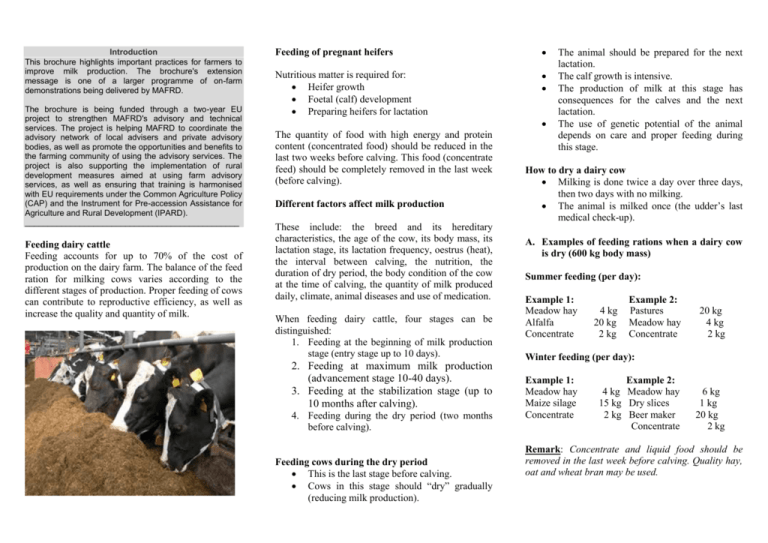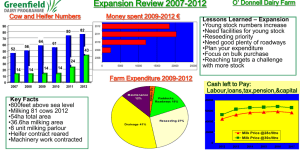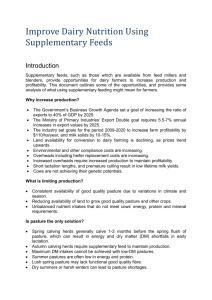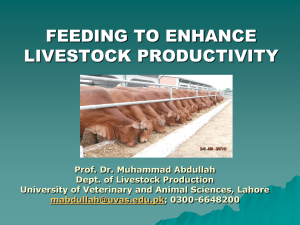feeding and ration formulation for milking cows
advertisement

Introduction This brochure highlights important practices for farmers to improve milk production. The brochure's extension message is one of a larger programme of on-farm demonstrations being delivered by MAFRD. The brochure is being funded through a two-year EU project to strengthen MAFRD's advisory and technical services. The project is helping MAFRD to coordinate the advisory network of local advisers and private advisory bodies, as well as promote the opportunities and benefits to the farming community of using the advisory services. The project is also supporting the implementation of rural development measures aimed at using farm advisory services, as well as ensuring that training is harmonised with EU requirements under the Common Agriculture Policy (CAP) and the Instrument for Pre-accession Assistance for Agriculture and Rural Development (IPARD). _______________________________________________ Feeding dairy cattle Feeding accounts for up to 70% of the cost of production on the dairy farm. The balance of the feed ration for milking cows varies according to the different stages of production. Proper feeding of cows can contribute to reproductive efficiency, as well as increase the quality and quantity of milk. Feeding of pregnant heifers Nutritious matter is required for: Heifer growth Foetal (calf) development Preparing heifers for lactation The quantity of food with high energy and protein content (concentrated food) should be reduced in the last two weeks before calving. This food (concentrate feed) should be completely removed in the last week (before calving). Different factors affect milk production These include: the breed and its hereditary characteristics, the age of the cow, its body mass, its lactation stage, its lactation frequency, oestrus (heat), the interval between calving, the nutrition, the duration of dry period, the body condition of the cow at the time of calving, the quantity of milk produced daily, climate, animal diseases and use of medication. When feeding dairy cattle, four stages can be distinguished: 1. Feeding at the beginning of milk production stage (entry stage up to 10 days). 2. Feeding at maximum milk production (advancement stage 10-40 days). 3. Feeding at the stabilization stage (up to 10 months after calving). 4. Feeding during the dry period (two months before calving). Feeding cows during the dry period This is the last stage before calving. Cows in this stage should “dry” gradually (reducing milk production). The animal should be prepared for the next lactation. The calf growth is intensive. The production of milk at this stage has consequences for the calves and the next lactation. The use of genetic potential of the animal depends on care and proper feeding during this stage. How to dry a dairy cow Milking is done twice a day over three days, then two days with no milking. The animal is milked once (the udder’s last medical check-up). A. Examples of feeding rations when a dairy cow is dry (600 kg body mass) Summer feeding (per day): Example 1: Meadow hay Alfalfa Concentrate 4 kg 20 kg 2 kg Example 2: Pastures Meadow hay Concentrate 20 kg 4 kg 2 kg Winter feeding (per day): Example 1: Meadow hay Maize silage Concentrate Example 2: 4 kg Meadow hay 15 kg Dry slices 2 kg Beer maker Concentrate 6 kg 1 kg 20 kg 2 kg Remark: Concentrate and liquid food should be removed in the last week before calving. Quality hay, oat and wheat bran may be used. B. Examples of feeding rations for cows in full lactation (600 kg body mass) 2. Cows with high milk production should consume at least 4% of digestive dry matter (DDM) of their live weight. Food 3. Feeding green food straight after milking stimulates DDM consumption. Meadow hay Alfalfa hay Maize silage Concentrate Quantity of milk produced/ per day 10 lit 17 lt 20 lt 25 lt 2 4 25 10 4 3 12 4 10 3 2 3 25 6.5 Rations for calves with body weight of up to 250 kg Example 1 (per day in kg): Hay 3.2 kg Concentrate 4 kg Or Silage 7 kg Concentrate 3.6 kg Rations for calves with body weight of up to 400 kg Example 2 (per day in kg): Hay 3 kg Concentrate 6.5 kg Or Silage 13 kg Concentrate 4.5 kg 1. The cow should be stimulated to achieve maximum consumption up to 10 weeks after calving; (checks for milk increase to be made every 15 days). Rural Agricultural Advisory Service of Kosovo 4. Cows should have food available for at least 20 hours a day. 5. Food in a feed trough should be stirred (rolled). 6. The DDM content in a ration of voluminous food should be 50-75%. 7. If stall temperature is over 27º C and relative humidity over 80%, then 60% of food should be given to cows during night time. FEEDING AND RATION FORMULATION FOR MILKING COWS 8. Cows should have sufficient drinking water available 24 hours, (as they drink up to 4 litres of water for every one litre of milk produced). 9. Milk production from heifers is 25% lower than from cows which have stopped growing. 10. Consumption of quantities of voluminous food increases the fat quantity in milk. 11. Voluminous food should be chopped (2.5-3 cm) to stimulate salivation. Very fine food has a counter-productive effect. 12. Protein energy deficiency is often present in cows. Practical recommendations when feeding dairy cows: An EU funded project managed by the European Office in Kosovo MINISTRY OF AGRICULTURE, FORESTRY AND RURAL DEVELOPMENT 13. Cows should be fed with hay prior to feeding silage. Source of technical information: Prof. Dr. Ragip Kastrati, Agriculture Faculty Implemented by consortium CA17 International (lead), Chambre d’Agriculture Charente Maretime (partner) & Etcharry Formation Developement (partner) (all from France), and Novus Consulting (partner from Kosova) Implemented by:






